.
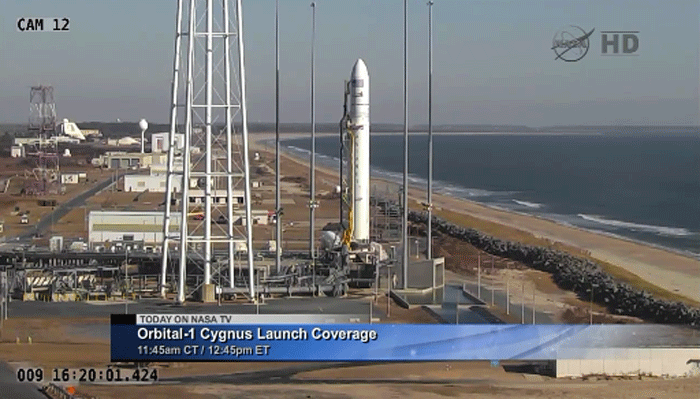
Antares rocket launch, U.S. Cargo Ship Launches to ISS on First Resupply Mission, January 9, 2014
.

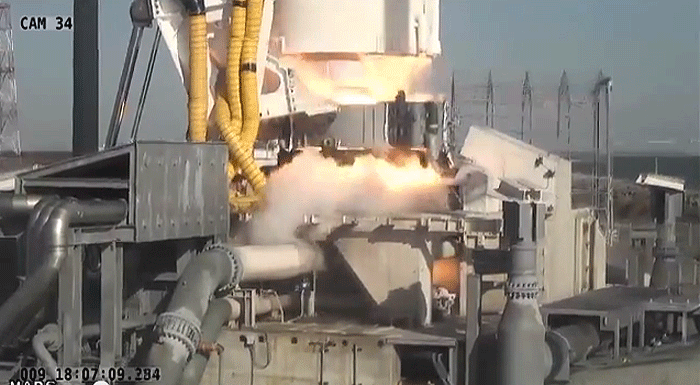
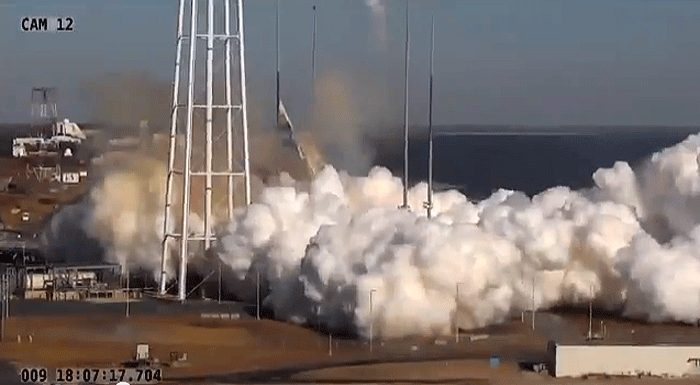
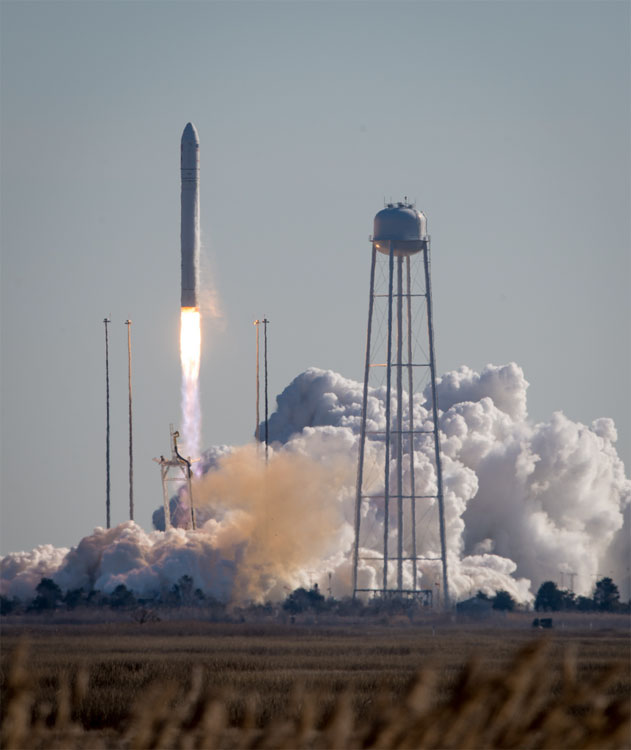
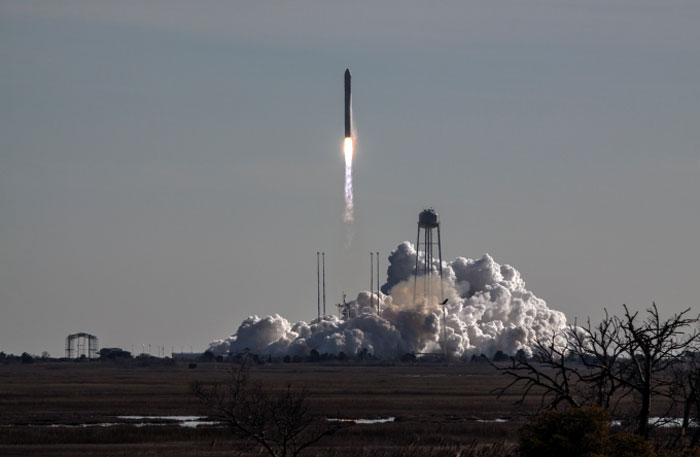
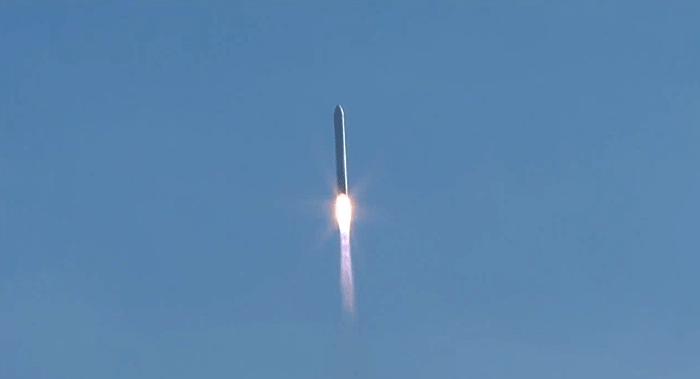
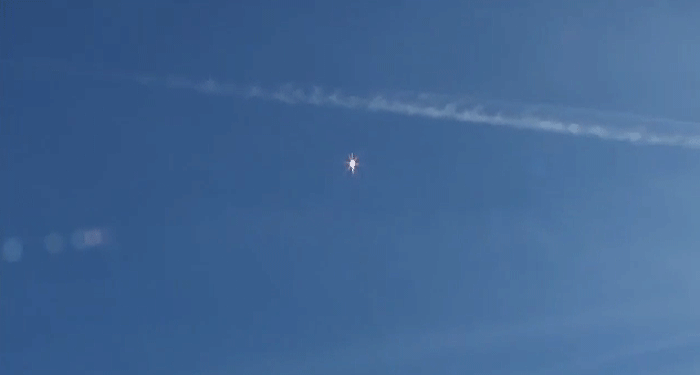
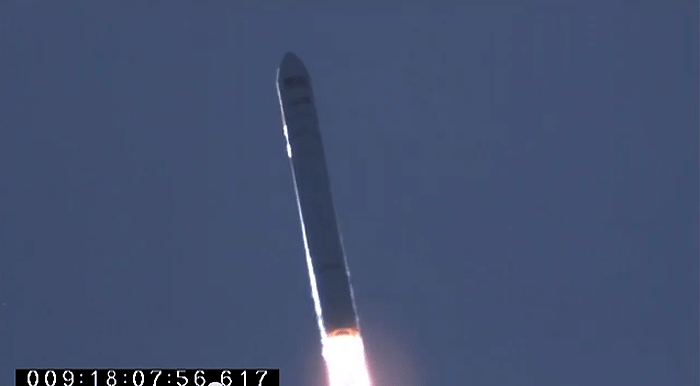
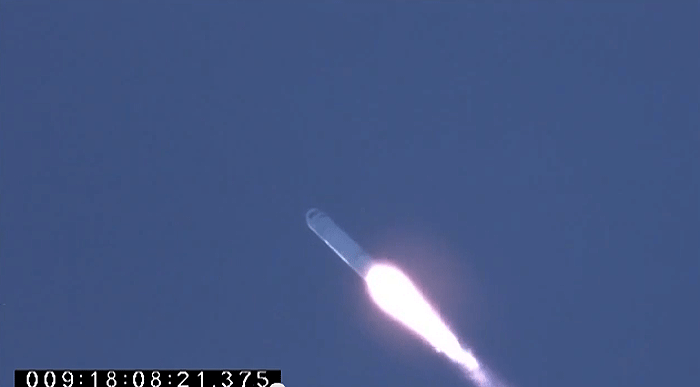
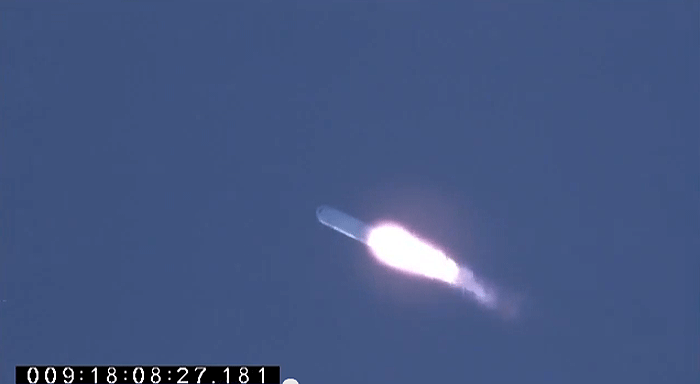
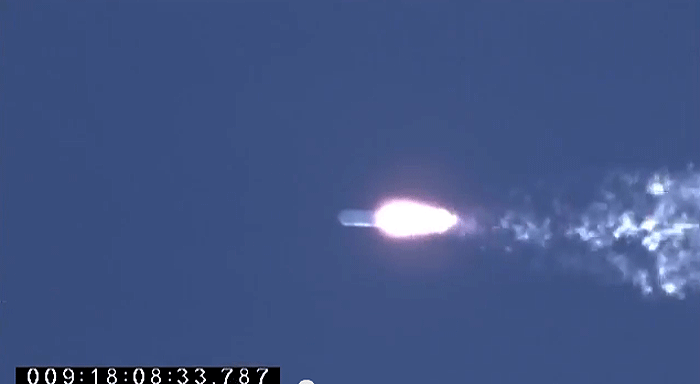
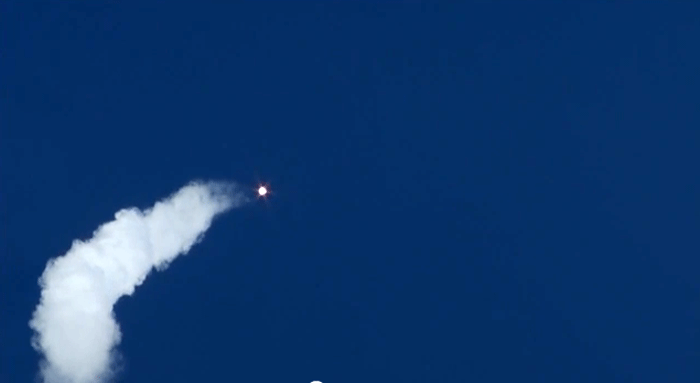
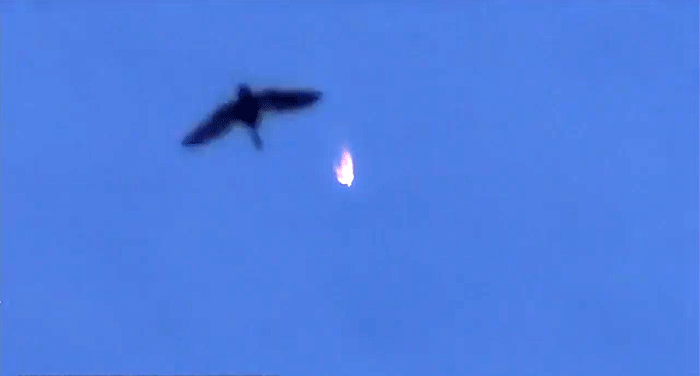
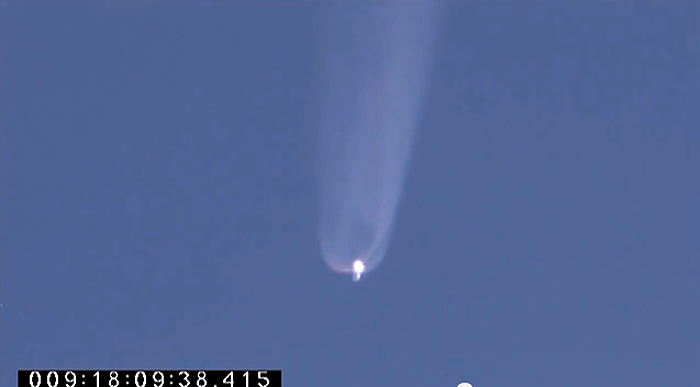
| Orbital Successfully Launches Antares Rocket Carrying Cygnus Spacecraft on Cargo Resupply Mission to International Space Station | |
| -- Company Completes Third Successful Antares Launch in the Past Nine Months -- | |
|
(Dulles, VA 9 January 2014) – Orbital Sciences Corporation (NYSE: ORB), one of the world’s leading space technology companies, today announced it successfully launched its Antares™ medium-class rocket carrying the first of eight Cygnus™ cargo logistics spacecraft missions to the International Space Station (ISS) as part of its $1.9 billion Commercial Resupply Services (CRS) contract with NASA. The launch of Orbital’s Antares rocket and Cygnus cargo logistics spacecraft will culminate in rendezvous and berthing with the ISS on Sunday, January 12 at approximately 6:00 a.m. (EST). Cygnus will deliver approximately 2,780 lbs. (1,260 kg.) of cargo to the Expedition 38 astronauts and remain attached to the station until February 18 before departing with approximately 2,800 lbs. (1,300 kg.) of disposable cargo for a safe, destructive reentry over the Pacific Ocean. Lift-off of Orbital’s Antares rocket occurred today at 1:07 p.m. (EST) from NASA’s Wallops Flight Facility in eastern Virginia. Following a 10-minute ascent, the Cygnus spacecraft was successfully deployed by the Antares upper stage and placed into its intended orbit of about 135 x 175 miles (220 X 280 km) above the Earth, inclined at 51.6 degrees to the equator. Approximately 25 minutes later, Orbital’s engineering team confirmed that reliable communications had been established and that the solar arrays were fully deployed, providing the necessary electrical power to command the spacecraft. “It was another excellent launch of Antares, and so far, our first CRS mission is off to a great start with Cygnus operating exactly as anticipated at this early stage of the mission,” said Mr. David W. Thompson, Orbital’s President and Chief Executive Officer. “Our team has put in a lot of hard work to get to the point of performing regular ISS cargo delivery trips for NASA. It’s an exciting day for all of us and I’m looking forward to completing this and our future CRS missions safely and successfully for our NASA customer.” Under a $1.9 billion CRS contract with NASA, Orbital will use Antares and Cygnus to deliver up to 44,000 pounds (20,000 kilograms) of cargo to the ISS over eight missions through late 2016. For these missions, NASA will manifest a variety of essential items based on ISS program needs, including food, clothing, crew supplies, spare parts and equipment, and scientific experiments. Orbital privately developed the Antares launch vehicle to provide low-cost, reliable access to space for medium-class payloads. It is the largest and most complex rocket the company has ever produced. Under the Commercial Orbital Transportation Services (COTS) joint research and development initiative with NASA, Orbital also developed the Cygnus spacecraft, which is an advanced maneuvering vehicle that meets the stringent human-rated safety requirements for ISS operations. Together, these products showcase Orbital’s ability to apply rigorous engineering approaches and commercial business practices to significantly shorten development timelines and lower operational costs of sophisticated space systems as compared to traditional government-run programs. |
|
|
Quelle: Orbital |
Planet Labs’ mini-satellites take flight toward the International Space Station
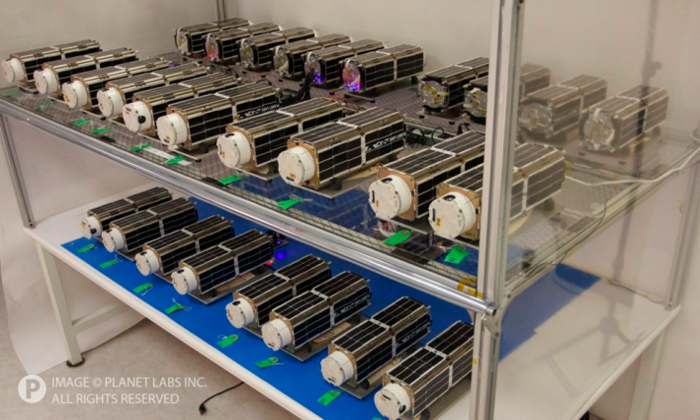
SF Startup Launches Eyes in the Sky
Orbital Sciences' Cygnus capsule chasing International Space Station for Sunday rendezvous
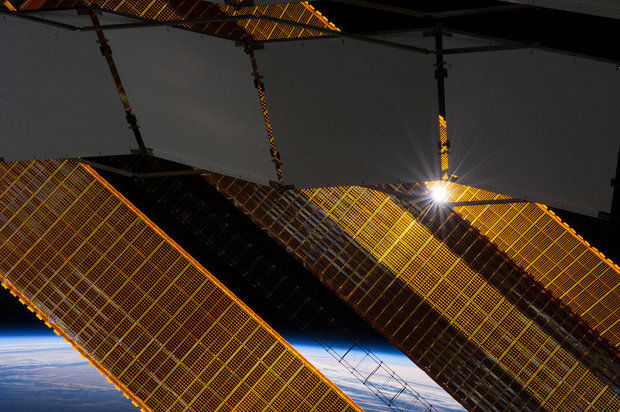
A tiny representation of the sun sneaks through between a truss-based radiator panel and a primary solar array panel on the Earth-orbiting International Space Station in this photograph taken by one of the Expedition 38 crew members. (NASA photo)
.
A commercial space capsule is chasing the International Space Station today carrying almost 3,000 pounds of supplies and science experiments. The Cygnus capsule launched by Orbital Sciences Corp. Thursday will rendezvous with the station Sunday morning in a maneuver televised on NASA TV beginning at 5 a.m. CST. The grapple of the capsule by the station's Canadarm2 is set for 6:02 a.m. CST.The capsule was launched Thursday and has already fired its maneuvering rockets four times to home in on the station it is chasing. The station turned on a beacon today that will guide the capsule closer. On board are 2,780 pounds of supplies (provisions and spare parts), grown-up science experiments and 23 student experiments involving 9,000 students on the ground. Experiments include observations of ants and a study that could lead to better understanding of drug-resistant bacteria.
Quelle: All Alabama
.
Update: 12.01.2014 / 14.00 MEZ
,
US space freighter Cygnus docking with ISS
The ISS crew is to catch the Cygnus with a 17-metre robotic arm and then the spaceship will be brought to a docking compartment on the U.S. module Harmony
The ISS crew is to catch the Cygnus with a 17-metre robotic arm and then the spaceship will be brought to a docking compartment on the U.S. module Harmony.
The rocket Antares has launched the Cygnus to the ISS on January 9 from a NASA spaceport on Wallops Island, Virginia, U.S. Atlantic Coast. At first the rocket launch was scheduled at December 19, 2013, but it was delayed over a malfunction in the cooling system on the U.S. segment of the ISS that made the astronauts going on a spacewalk to eliminate this break. When the malfunction was eliminated, the launch was slated on January 7, but it was delayed at the last moment due to a strong solar storm in the Earth’s magnetic field that threatened the electric equipment of the rocket with breakdowns.
The freight spaceship Cygnus, which like the booster, was created by private U.S. company Orbital Sciences, is delivering more than 1.3 tonnes of different cargoes, including food, water, spare parts, equipment and material for scientific experiments to the crewmembers of the 38th ISS expedition.
Quelle: ITARTASS
.
ISS Crew Grapples Cygnus
International Space Station Expedition 38 crew members Michael Hopkins of NASA and Koichi Wakata of the Japan Aerospace Exploration Agency captured the Orbital Sciences Cygnus cargo spacecraft with the station’s robotic arm at 6:08 a.m. EST as the station and the resupply vehicle flew 260 statute miles over the Indian Ocean, northeast of Madagascar. The spacecraft now will be maneuvered by Wakata for Cygnus’ installation onto the Earth-facing port of the station's Harmony module
.
LIVE-Frams NASA-TV
.
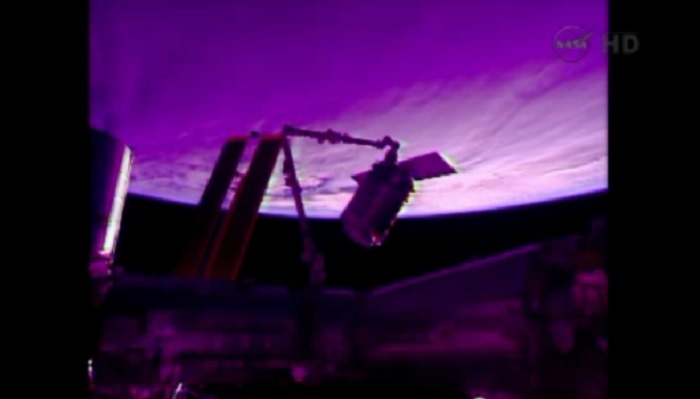
.
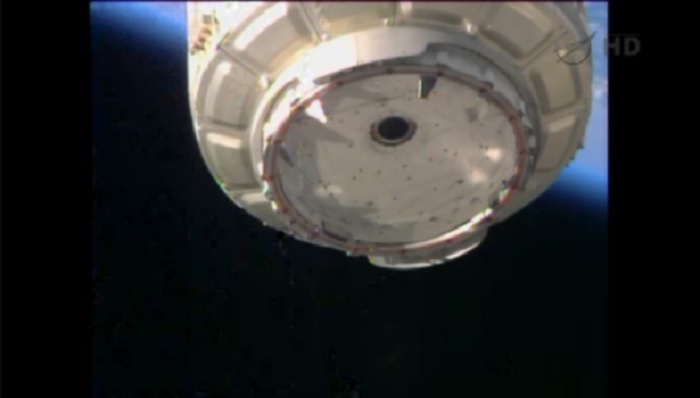
.
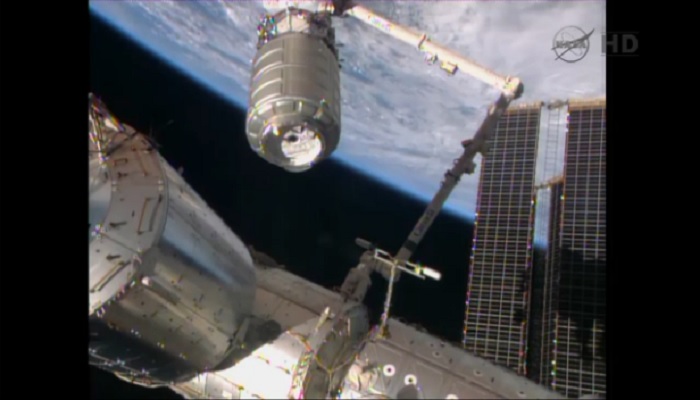
.
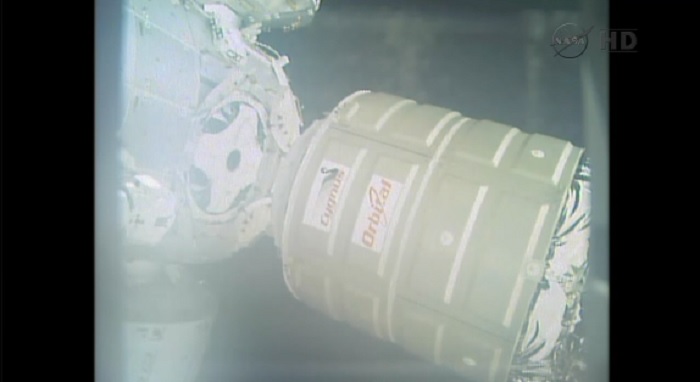
.
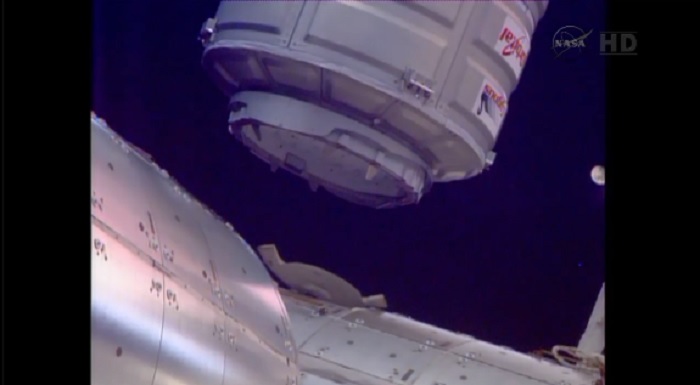
.
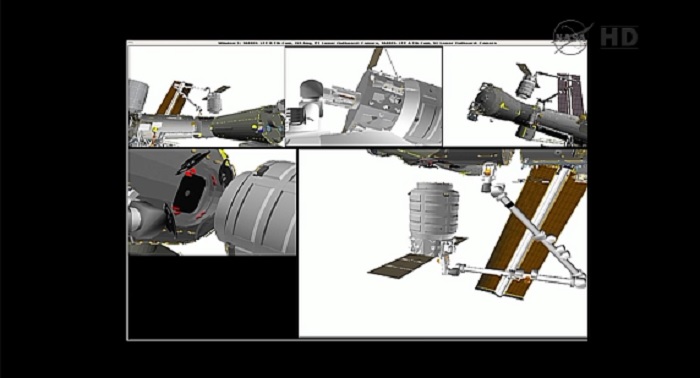
.

.
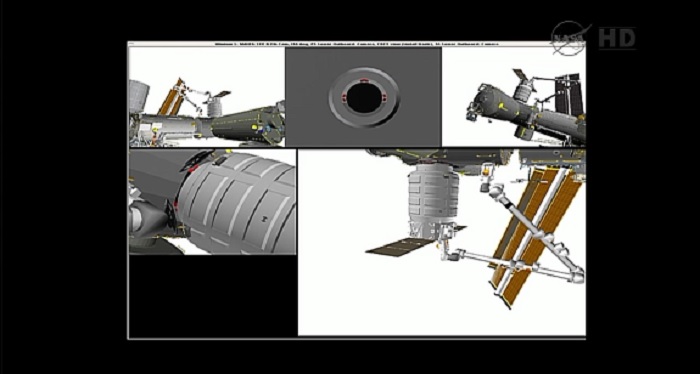
.
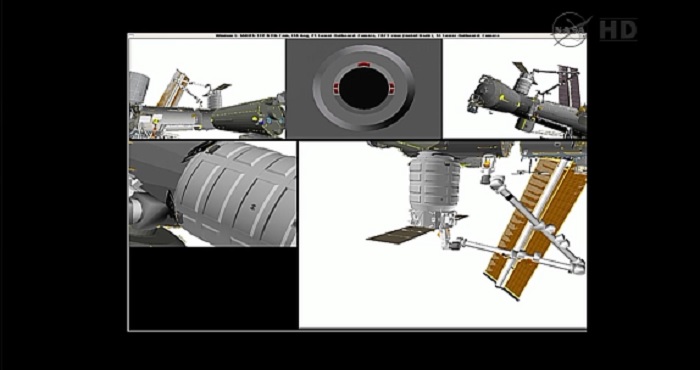
.
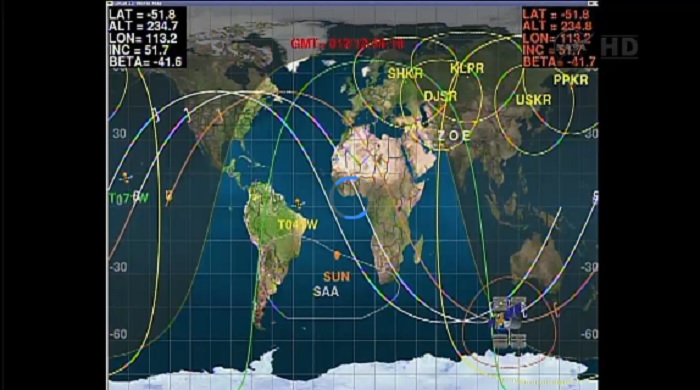
Quelle: NASA
.
Update: 17.30 MEZ
.
Christmas delivery finally arrives at space station
A fresh batch of supplies and science experiments, including one designed by Florida high school students, has reached the International Space Station.
Expedition 38 astronauts captured Orbital Sciences Corp.'s unmanned Cygnus cargo freighter at 6:08 a.m. EST, three days after its launch from Virginia on an Antares rocket.
Steering a 58-foot robotic arm, astronaut Mike Hopkins snared the barrel-shaped spacecraft carrying nearly 2,800 pounds of supplies as the two vehicles flew 260 miles over the Indian Ocean, travelling 17,500 mph.
Hopkins radioed congratulations to the ground, noting that the Cygnus was the second he'd seen during his three-and-a-half months living on the station, starting with a maiden demonstration mission last fall.
"I think that's very impressive," he said.
Orbital Sciences Corp. was supposed to make the delivery last month, well before Christmas. But the Virginia company had to wait a month. A space station breakdown in mid-December took priority, and NASA bumped the flight to January in order to repair the disabled cooling system at the orbiting outpost. Then frigid weather at the launch site forced a delay. Then a strong solar storm interfered.
The capture this morning completed the first of eight planned Cygnus trips to the station under a $1.8 billion NASA resupply contract.
Astronaut Koichi Wakata of Japan was set to take over the robotic arm's controls to attach the Cygnus to a Harmony node port within a couple of hours.
The crew might have time to open the Cygnus hatch today, to remove the time-sensitive "Ants in Space" experiment, or it could be done Monday.
Another experiment on board was designed by students from West Shore Jr./Sr. High in Melbourne, Fla., one of 17 projects selected by the Student Spaceflight Experiment Project.
The experiment honors their former teacher, Jason Whitworth, who was stricken with amyotrophic lateral sclerosis, or Lou Gehrig's Disease.
The Cygnus is expected to stay berthed at the station for about 40 days.
Unlike SpaceX's Dragon, which has completed two resupply missions under a $1.6 billion contract and is targeting launch of a third next month from Cape Canaveral, the Cygnus will not return to Earth.
Instead it will be packed with trash, freeing up valuable space on the station, and burn up in the atmosphere when its mission is complete.
Quelle: USA Today
.
New NASA Science Arrives at Space Station Aboard Orbital Sciences Cygnus Spacecraft
.
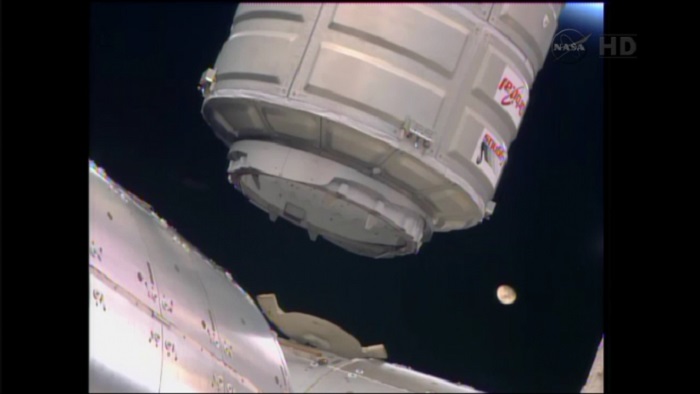
Astronauts aboard the International Space Station Sunday used a robotic arm to capture and attach the Cygnus supply spacecraft, which carried dozens of new science experiments from across the country and the world to the orbiting laboratory. The arrival capped the first successful contracted cargo delivery by Orbital Sciences Corp. of Dulles, Va., for NASA.
Astronaut Mike Hopkins of NASA grappled the spacecraft at 6:08 a.m. EST and Koichi Wakata of the Japan Aerospace Exploration Agency attached Cygnus to the space station's Harmony Node at 8:05 a.m. The Expedition 38 crew members aboard the station will begin unloading the 2,780 pounds (1,261 kilograms) of supplies aboard Cygnus following hatch opening planned for Monday.
The cargo is comprised of vital science experiments, crew provisions, spare parts and other hardware. This includes 23 student-designed science experiments. One newly arrived investigation will study the decreased effectiveness of antibiotics during spaceflight. Another will examine how different fuel samples burn in microgravity, which could inform future design for spacecraft materials.
Orbital's Cygnus was launched on the company's Antares rocket Thursday from the Mid-Atlantic Regional Spaceport Pad 0A at NASA’s Wallops Flight Facility in Virginia. Cygnus will remain attached to Harmony until a planned unberthing in February sends the spacecraft toward a destructive re-entry in Earth's atmosphere.
Orbital Sciences is one of two companies that built and tested new cargo spacecraft under NASA's Commercial Orbital Transportation Services (COTS) program. COTS was completed late last year with an Orbital Sciences demonstration mission to the space station. Space Exploration Technologies (SpaceX), the other company that partnered with NASA under COTS, also is providing commercial resupply services for the agency. U.S. commercial cargo delivery flights to the station help ensure a robust national capability to deliver critical science research to orbit, significantly increasing NASA's ability to conduct new science investigations aboard the only laboratory in microgravity.
In addition to cargo flights, NASA's commercial space partners are making progress toward a launch of astronauts from U.S. soil within the next three years.
The International Space Station is a convergence of science, technology and human innovation that demonstrates new technologies and makes research breakthroughs not possible on Earth. The space station has been continuously occupied since November 2000. In that time, it has been visited by more than 200 people and a variety of international and commercial spacecraft. The space station remains the springboard to NASA's next great leap in exploration, including future missions to an asteroid and Mars.
Quelle: NASA
.
Cygnus cargo craft arrives at ISS with West Shore experiment
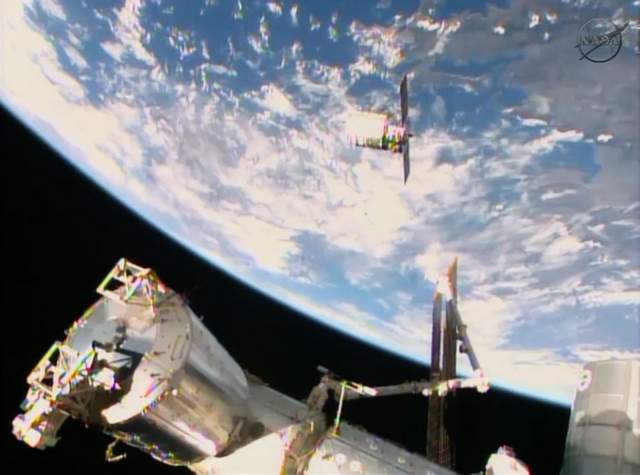
Orbital Sciences' Cygnus commercial resupply craft is on its final approach before being captured. Credit: NASA TV
.
A fresh batch of supplies and science experiments, including one designed by local high school students, has reached the International Space Station.Expedition 38 astronauts captured Orbital Sciences Corp.’s unmanned Cygnus cargo freighter at 6:08 a.m. EST, three days after its launch from Virginia on an Antares rocket.
Steering a 58-foot robotic arm, astronaut Mike Hopkins snared the barrel-shaped spacecraft carrying nearly 2,800 pounds of supplies as the two vehicles flew 260 miles over the Indian Ocean, travelling 17,500 mph.
Hopkins radioed congratulations to the ground, noting that the Cygnus was the second he’d seen during his three-and-a-half months living on the station, starting with a maiden demonstration mission last fall.
“I think that’s very impressive,” he said.
The capture this morning completed the first of eight planned Cygnus trips to the station under a $1.8 billion NASA resupply contract.
Astronaut Koichi Wakata of Japan was set to take over the robotic arm's controls to attach the Cygnus to a Harmony node port within a couple of hours.
The crew might have time to open the Cygnus hatch today, to remove the time-sensitive "Ants in Space" experiment, or it could be done Monday.
Another experiment on board was designed by students from West Shore Jr./Sr. High in Melbourne, one of 17 projects selected by the Student Spaceflight Experiment Project.
The experiment honors their former teacher, Jason Whitworth, who was stricken with amyotrophic lateral sclerosis, or Lou Gehrig’s Disease.
The Cygnus is expected to stay berthed at the station for about 40 days.
Unlike SpaceX’s Dragon, which has completed two resupply missions under a $1.6 billion contract and is targeting launch of a third next month from Cape Canaveral, the Cygnus will not return to Earth.
-- Rendezvous and Berthing Operations of Company’s First Operational Cargo Logistics Mission Proceeded Smoothly --
-- Cargo Unloading to Begin Tomorrow with 37-Day Stay at Station Planned --
(Dulles, VA 12 January 2014) – Orbital Sciences Corporation (NYSE: ORB), one of the world’s leading space technology companies, today announced that its Cygnus™ cargo logistics spacecraft successfully completed its rendezvous and approach maneuvers with the International Space Station (ISS) and was grappled and berthed with the station by the Expedition 38 astronaut crew earlier this morning. After Cygnus was launched into orbit by Orbital’s Antares™ rocket on Thursday, January 9 from NASA’s Wallops Flight Facility, it completed a series of thruster firings and other maneuvers bringing the spacecraft in close proximity to the ISS. Final approach to the station began at about 3:00 a.m. (EST) this morning, culminating with the station’s robotic arm grappling the spacecraft at 6:08 a.m. when it was about 30 feet (10 meters) from the ISS. Cygnus was then guided to its berthing port on the nadir side of the ISS’ Harmony module where its installation was completed at 8:05 a.m.
“Our first mission under the CRS contract with NASA was flawlessly executed by our Antares and Cygnus operations team, from the picture-perfect launch from NASA’s Wallops Flight Facility to the rendezvous, capture and berthing at the space station this morning,” said Mr. David W. Thompson, Orbital’s President and Chief Executive Officer. “From the men and women involved in the design, integration and test, to those who launched the Antares and operated the Cygnus, our whole team has performed at a very high level for our NASA customer and I am very proud of their extraordinary efforts.”
Cygnus will remain berthed at the ISS until February 18. Cygnus is delivering approximately 2,780 lbs. (1,260 kg.) of cargo and science payloads to the Expedition 38 astronauts. Either later today or tomorrow, the crew plans to open the Cygnus hatch and make initial ingress into its cargo module. Cygnus will remain attached to the station for 37 days before departing with approximately 2,800 lbs. (1,300 kg.) of disposable cargo for a safe, destructive reentry over the Pacific Ocean.
Under a $1.9 billion CRS contract with NASA, Orbital will use Antares and Cygnus to deliver up to 44,000 pounds (20,000 kilograms) of cargo to the ISS over eight missions, including the mission currently underway, through late 2016. For these missions, NASA will manifest a variety of essential items based on ISS program needs, including food, clothing, crew supplies, spare parts and equipment, and scientific experiments.
About Cygnus
Orbital developed the Cygnus cargo spacecraft as part of its COTS joint research and development initiative with NASA. Cygnus consists of a common Service Module (SM) and a Pressurized Cargo Module (PCM). The SM incorporates avionics, power, propulsion and communications systems already successfully flown aboard dozens of Orbital’s LEOStar™ and GEOStar™ satellites. The PCM, designed and built by Thales Alenia Space under a subcontract from Orbital, is based on the Multi-Purpose Logistics Module (MPLM) previously used with the Space Shuttle. With a full load of cargo and fuel, the standard-configuration Cygnus weighs about 5,200 kg at launch and generates 3.5 kw of electrical power while in orbit. It is capable of extended-duration missions of a year or longer in space.
Quelle: Orbital
